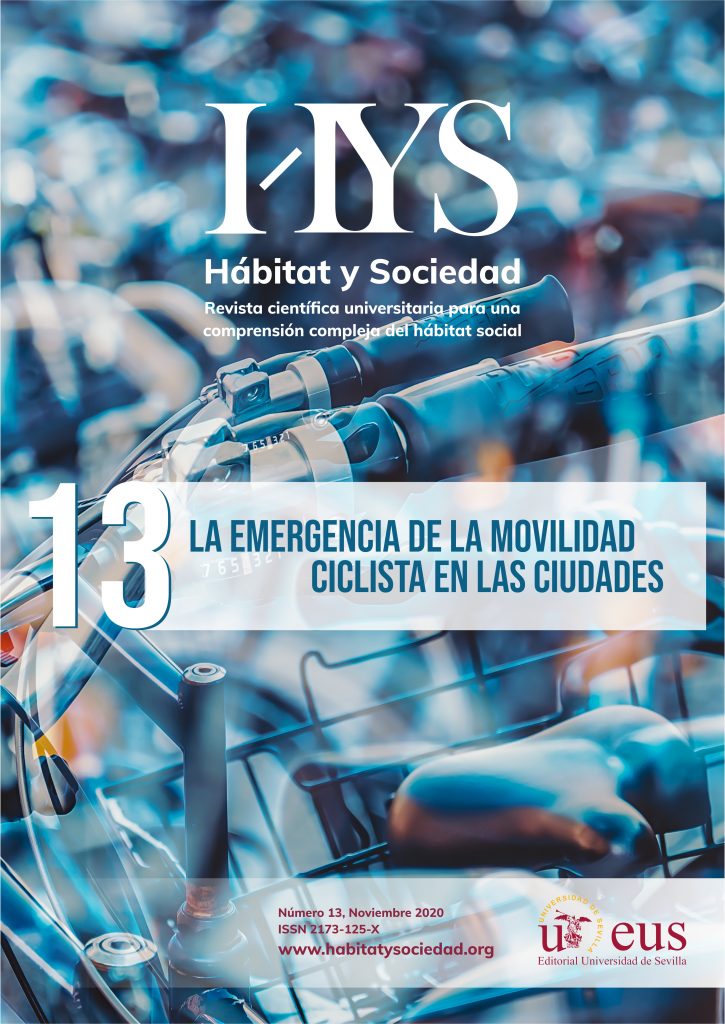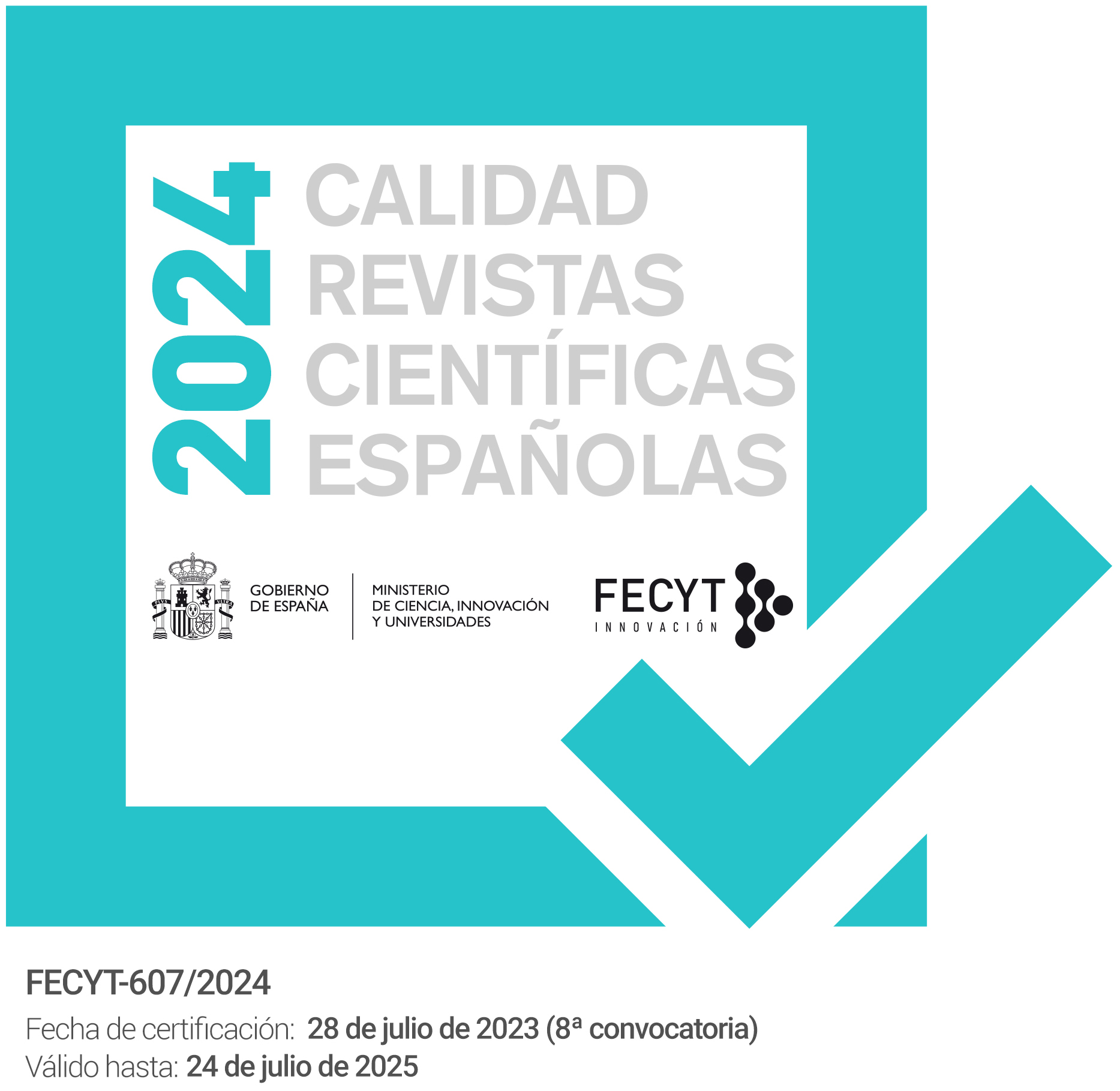De Rutas Seguras a Rutas Bakanes en Chile: Co-creación con enfoque de género, educación cívica y derechos
DOI:
https://doi.org/10.12795/HabitatySociedad.2020.i13.10Palabras clave:
Rutas seguras, educación, transporte sustentable, transporte activo, enfoque de derechos, niñ@s, innovaciónResumen
Una literatura internacional, principalmente de países sajones, examina la utilidad de programas denominados “Safe Routes to School” o Rutas Seguras a las Escuelas, para fomentar el transporte activo (principalmente la caminata y la bicicleta) y con ello los niveles de actividad física suficientes para mejorar la salud física y mental. Hasta la fecha, este tipo de programas ha sido implementado casi exclusivamente en el hemisferio norte, particularmente en Canada, el Reino Unido, y los Estados Unidos, donde han recibido apoyo de redes nacionales y diferentes niveles del gobierno.
Este artículo presenta la experiencia de una adaptación de estos programas en escuelas vulnerables de varias ciudades chilenas (2016-2019), en el marco de una estrategia de investigación participativa para la acción.
Al cambiar de contexto, el marco general y los fundamentos del programa se transformaron profundamente, integrando un enfoque de género, educación cívica, y derechos, como parte integral del transporte sustentable, tomando en cuenta su dimensión social, la que a menudo es poco considerada.
El resultado fue cambios profundos en las actitudes, capacidades y visiones de las comunidades escolares.
Descargas
Citas
Almandoz, Arturo (2020). Universidad Simón Bolívar, Caracas, Venezuela. Reconsideraciones epistemológicas y conceptuales sobre el urbanismo. EURE (Santiago) vol.46 no.137 Santiago. https://scielo.conicyt.cl/scielo.php?script=sci_arttext&pid=S0250-71612020000100273&lng=en&nrm=iso&tlng=en
Alza Barco, Carlos. El enfoque basado en derechos, Pontificia Universidad Católica del Perú.
Anciaes, P. R., S. Boniface, A. Dhanani, J. Mindell and N. Groce (2016). "Urban transport and community severance: Linking research and policy to link people and places." Journal of Transport Health 3: 268-277.
Appleyard, D., M. S. Gerson and M. Lintell (1981). Livable streets. Berkeley, London, University of California Press.
Argyris, Chris and Donald Schön (1974). Theory in practice Increasing professional effectiveness. San Francisco, US, John Wiley & Sons.
Barber, B. R. (1998). A place for us : how to make society civil and democracy strong. New York, Hill and Wang.
Beckmann, J. (2001). "Automobility a social problem and theoretical concept." Environment and Planning D: Society and Space 19: 593-607.
Boniface, S., R. Scantlebury, S. Watkins and J. Mindell (2015). "Health implications of transport: Evidence of effects of transport on social interactions." Journal of Transport Health.
Cavill, Nick (2003). The potential of non-motorised transport for promoting health. Sustainable transport Planning for walking and cycling in urban environments. R. Tolley. Boca Raton, FL; Cambridge, England, CRC Press (North America); Woodhead Publishing Limited (UK): xxi, 713 p.
De Souza Briggs, X. N. (2008). Democracy as problem solving: civic capacity in communities across the globe. Cambridge, MA, MIT Press.
Elvik, R. and T. Bjørnskau (2017). "Safety-in-numbers: A systematic review and meta-analysis of evidence." Safety Science 92: 274-282.
Fainstein, Susan S. (2010). The Just City. Ithaca, Cornell University Press.
Faludi, Andreas (1978). Essays on planning theory and education. Oxford [Eng.] ; New York, Pergamon Press.
Freire, Paulo (1998). Pedagogía de Autonomía. Lanham, Rowman & Littlefield Publishers.
Friedman, Victor (2008). Action Science: Creating communities of Inquiry in Communities of Practice. The Sage handbook of action research: participative inquiry and practice, Concise Paperback Edition. P. Reason and H. Bradbury. London, SAGE: xxxii, 720 p.
Friedmann, John (2011). Insurgencies: essays in planning theory. New York, Routledge.
Frumkin, H., L. D. Frank and R. Jackson (2004). Urban sprawl and public health : designing, planning, and building for healthy communities. Washington, DC, Island Press.
Gehl, Jan (2011). Life between buildings : using public space. Washington, DC, Island Press.
Meadows, Donella H., Dennis L. Meadows and J© rgen Randers (2004). "Limits to growth : the 30-year update." xxii, 338 p.
Götschi, T., J. Garrard and B. Giles-Corti (2015). "Cycling as a Part of Daily Life: A Review of Health Perspectives." Transport Reviews: 1-27.
Hartell, A. M. (2009). "Is Inadequate Transportation a Barrier to Community Involvement? Evidence from the Social Capital Benchmark Survey." Transportation Research Record 2067: 11-16.
Heinrich, K. M., N. Aki, H. Hansen-Smith, M. Fenton and J. Maddock (2011). "A Comprehensive Multi-Level Approach for Passing Safe Routes to School and Complete Streets Policies in Hawaii." Journal of Physical Activity and Health 8(Supplement): 136-140.
Hillman, M. (1999). The Impact of Transport Policy on Children's Development. Canterbury Safe Routes to Schools Project Seminar. C. C. C. U. College. Christ Church University College.
Hillman, M., J. Adams and J. Whitelegg (1990). One false move : a study of children's independent mobility. London, Policy Studies Institute.
Hui, N., S. Saxe, M. Roorda, P. Hess and E. J. Miller (2017). "Measuring the completeness of complete streets." Transport Reviews 38(1): 73-95.
Institute, O. P. P. (2017). Complete Streets.
Jacobsen, P. L. (2003). "Safety in numbers: more walkers and cyclists, safer walking and bicycling." Injury Prevention 9: 205-209.
Jacobsen, P. L., D. Ragland and C. Komanoff (2015). "Safety in Numbers for walkers and bicyclists: exploring the mechanisms." Injury Prevention 0(0).
LTAAcademy, S. (2011). "Passenger Transport Mode Shares in World Cities." Journeys, Land Transport Authority Academy Singapore November 2011.
Mindell, J. (2017). Transport, Health, and Inequalities.
Mindell, J. (2018). "Editorial Every breath we take, every move we make." Journal of Transport & Health 10: 1-2.
Mindell, J., S. Watkins and J. Cohen (2011). Health on the Move 2. Policies for Health Promoting Transport. Stockport, Transport and Health Study Group.
Mueller, N., D. Rojas-Rueda, T. Cole-Hunter, A. de Nazelle, E. Dons, R. Gerike, T. Gotschi, L. Int Panis, S. Kahlmeier and M. Nieuwenhuijsen (2015). "Health impact assessment of active transportation: A systematic review." Prev Med 76: 103-114.
NCSRS and CSN (2011). Personal Security and Safe Routes to School. Washington, DC, National Center for Safe Routes to School, Children’s Safety Network.
Oficina del Alto Comisionado de las Naciones Unidas para los Derechos Humanos, (2006), “Preguntas frecuentes sobre el enfoque de Derechos Humanos” Nueva York y Ginebra: ONU, 2006.https://www.ohchr.org/Documents/Publications/FAQsp.pdf Página 15, 16. (27/01/2020)
Páez, Orellana, Katherine. Conferencia Internacional sobre la Población y el Desarrollo CIPD. Avances en América Latina (2009-2011) Katherine Páez Orellana. https://repositorio.cepal.org/bitstream/handle/11362/7141/1/S1200566_es.pdf
Putnam, R. D. (2000). Bowling alone : the collapse and revival of American community. New York, Simon & Schuster.
Reason, Peter and Hilary Bradbury (2006). Handbook of Action Research, concise paperback edition. London, New Delhi, Sage Publications.
Replogle, Michael (1992). "Bicycles adn cycle-rickshaws in Asian cities: issues and strategies." Transportation Research Record 1372.
Rojas-Rueda, David, Audrey De Nazelle, Marko Tainio and Mark J Nieuwenhuijsen (2011). "The health risks and benefits of cycling in urban environments compared with car use: health impact assessment study." British Medical Journal 343: 1-8.
Root, Amanda (2003). Delivering sustainable transport : a social science perspective. Amsterdam ; New York, Pergamon.
Rydin, Y. (2012). "Viewpoint: Healthy cities and planning." TPR The Town Planning Review 83(4).
Rydin, Y., A. Bleahu, M. Davies, J. D. Dávila, S. Friel, G. De Grandis, N. Groce, P. Hallal, I. Hamilton, P. Howden-Chapman, K.-M. Lai, C. Lim, J. Marins, D. Osrin, I. Ridley, I. Scott, M. Taylor, P. Wilkinson and J. Wilson (2012). "Shaping cities for health: complexity and the planning of urban environments in the 21st century." The Lancet 379(June 2): 2079-2108.
SafeRoutesPartnership. (2019). "Safe Routes to School." Retrieved 9 February, 2019, from https://www.saferoutespartnership.org/safe-routes-school.
SafeRoutesUS. (2018). "Safe Routes Partnership." from https://www.saferoutespartnership,org.
Sagaris, L. and A. Arora (2016). "Evaluating how cycle-bus integration could contribute to "sustainable" transport." Research in Transportation Economics 59(November): 218-227.
Sagaris, L. and I. Tiznado-Aitken (2018). Walking and gender equity: Insights from Santiago Chile. Latin American Studies Association. N. Villamizar-Duarte, D. Hernández Oviedo and A. M. Ardila Pinto. Barcelona, Spain.
Sagaris, L., I. Tiznado-Aitken and S. Steiniger (2017). "Exploring the social and spatial potential of an intermodal approach to transport planning." International Journal of Sustainable Transportation 11(10): 721-736.
Sagaris, Lake (2018). "Citizen participation for sustainable transport: Lessons for change from Santiago and Temuco, Chile." Research in Transportation Economics on-line: 1-8.
Sagaris, Lake (2019). Otra clase de amor: Ciudad Viva y el nacimiento de un urbanismo ciudadano en Chile. Santiago, Chile, RIL Editores, CEDEUS.
Sagaris, Lake and Daniel Lanfranco (2019). "Beyond “Safe”: Chilean “Kool” Routes to School Address Social Determinants of Health." Journal of Transport & Health 15.
Sandercock, Leonie (1998). Making the invisible visible : a multicultural planning history. Berkeley, University of California Press.
Shanbaug, Amit (2012). 'Rickshaw Bank' concept changes lives of thousands of pullers. The Economic Times. Delhi, India, India Times. E-version.
Sheller, M. and J. Urry (2000). "The City and The Car." International Journal of Urban and Regional Research 24(4).
Sirianni, C. (2009). Investing in democracy: engaging citizens in collaborative governance. Washington, D.C., Brookings Institution Press.
Smith-Lea, N., R. Mitra and P. Hess (2015). The Complete Streets Catalogue: Understanding Complete Streets in the Greater Golden Horseshoe Region. Toronto, Canada, Toronto Centre for Active Transportation, Clean Air Partnership, University of Toronto, Ryerson University.
Speth, James Gustave (2008). The Bridge at the Edge of the World. New Haven and London, Yale University Press.
Tolley, Rodney (2003). Sustainable transport : planning for walking and cycling in urban environments. Boca Raton, FL; Cambridge, England, CRC Press (North America); Woodhead Publishing Limited (UK).
Tainio, M., A. J. de Nazelle, T. Gotschi, S. Kahlmeier, D. Rojas-Rueda, M. J. Nieuwenhuijsen, T. H. de Sa, P. Kelly and J. Woodcock (2016). "Can air pollution negate the health benefits of cycling and walking?" Prev Med 87: 233-236.
Teschke, K., C. C. Reynolds, F. Ries, B. Gouge and M. Winters (2012). "Bicycling: Health Risk or Benefit?" UBC Medical Journal 3(2): 6-11.
UNEP/FIA (2016). Global Outlook on Walking and Cycling, United Nations Environmental Program, FIA Foundation.
UN. (2015). "Sustainable Development Goals." Retrieved 30 September, 2019, from http://www.undp.org/content/undp/es/home/sustainable-development-goals.html.
UNHabitat. (2016). "New Urban Agenda." Retrieved 28 January, 2019, from http://habitat3.org/the-new-urban-agenda.
Urry, J. (2004). "The System of Automobility." Theory, Culture Society 21(4-5): 25-39.
WHO (2008). Closing the gap in a generation: Health equity through action on the social determinants of health. F. R. Commission on Social Determinants of Health, World Health Organization.
WHO (2010). A Conceptual Framework for Action on the Social Determinants of Health. Discussion paper series on Social Determinants of Health. Geneva, Switzerland, World Health Organization.
Winters, A., R. Mitra, N. Smith-Lea and P. Hess (2015). Understanding Complete Streets How do professionals define a complete street project. Transportation Research Board. Washington, DC, TRB.
Descargas
Publicado
Cómo citar
Número
Sección
Licencia
Derechos de autor 2020 De los autores y Editorial Universidad de Sevilla

Esta obra está bajo una licencia internacional Creative Commons Atribución-NoComercial-CompartirIgual 4.0.
Los textos publicados se considerarán propiedad intelectual de los autores y de la revista. Podrán ser usados para usos educativos y académicos, citando al autor y la publicación, con la dirección electrónica exacta. En todo caso, deberá comunicarse este tipo de uso y pedir la autorización del mismo a la dirección de la revista.
Los autores/as que publiquen en esta revista aceptan las siguientes condiciones:
- Los autores/as conservan los derechos de autor y ceden a la revista el derecho de la primera publicación, con el trabajo registrado con la licencia de atribución de Creative Commons, que permite a terceros utilizar lo publicado siempre que mencionen la autoría del trabajo y la primera publicación en esta revista.
- Los autores/as pueden realizar otros acuerdos contractuales independientes y adicionales para la distribución no exclusiva de la versión del artículo publicado en esta revista (p. ej., incluirlo en un repositorio institucional o publicarlo en un libro) siempre que indiquen claramente que el trabajo se publicó por primera vez en esta revista.
- Se permite y recomienda a los autores/as publicar su trabajo en Internet (por ejemplo en páginas institucionales o personales) antes y durante el proceso de revisión y publicación, ya que puede conducir a intercambios productivos y a una mayor y más rápida difusión del trabajo publicado (véase The Effect of Open Access).













